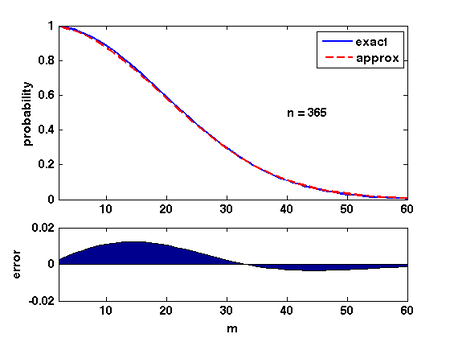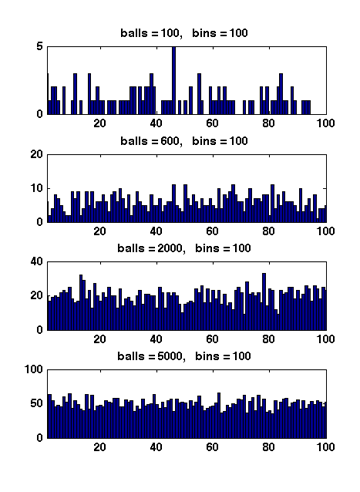随机算法 (Spring 2013)/Random Variables and Expectations
Random Variable
Definition (random variable) - A random variable
- A random variable
For a random variable
The independence can also be defined for variables:
Definition (Independent variables) - Two random variables
- for all values
- Two random variables
Note that in probability theory, the "mutual independence" is not equivalent with "pair-wise independence", which we will learn in the future.
Expectation
Let
Definition (Expectation) - The expectation of a discrete random variable
- where the summation is over all values
- The expectation of a discrete random variable
Linearity of Expectation
Perhaps the most useful property of expectation is its linearity.
Theorem (Linearity of Expectations) - For any discrete random variables
- For any discrete random variables
Proof. By the definition of the expectations, it is easy to verify that (try to prove by yourself): for any discrete random variables
The theorem follows by induction.
The linearity of expectation gives an easy way to compute the expectation of a random variable if the variable can be written as a sum.
- Example
- Supposed that we have a biased coin that the probability of HEADs is
- It looks straightforward that it must be np, but how can we prove it? Surely we can apply the definition of expectation to compute the expectation with brute force. A more convenient way is by the linearity of expectations: Let
The real power of the linearity of expectations is that it does not require the random variables to be independent, thus can be applied to any set of random variables. For example:
However, do not exaggerate this power!
- For an arbitrary function
- For variances, the equation
Conditional Expectation
Conditional expectation can be accordingly defined:
Definition (conditional expectation) - For random variables
- where the summation is taken over the range of
- For random variables
There is also a law of total expectation.
Theorem (law of total expectation) - Let
- Let
Random Quicksort
Given as input a set
- if
- pick an
- partition
- recursively sort
- pick an
The time complexity of this sorting algorithm is measured by the number of comparisons.
For the deterministic quicksort algorithm, the pivot is picked from a fixed position (e.g. the first number in the array). The worst-case time complexity in terms of number of comparisons is
We consider the following randomized version of the quicksort.
- if
- uniformly pick a random
- partition
- recursively sort
- uniformly pick a random
Analysis of Random Quicksort
Our goal is to analyze the expected number of comparisons during an execution of RandQSort with an arbitrary input
Let
Elements
Observation 1: Every pair of
Therefore the sum of
By the definition of expectation and
We are going to bound this probability.
Observation 2:
This is easy to verify: just check the algorithm. The next one is a bit complicated.
Observation 3: If
We can verify this by induction. Initially,
Combining Observation 2 and 3, we have:
Observation 4:
And,
Observation 5: Every one of
This is because the Random Quicksort chooses the pivot uniformly at random.
Observation 4 and 5 together imply:
| Remark: Perhaps you feel confused about the above argument. You may ask: "The algorithm chooses pivots for many times during the execution. Why in the above argument, it looks like the pivot is chosen only once?" Good question! Let's see what really happens by looking closely.
For any pair Formally, let The conditional probability rules out the irrelevant events in a probabilistic argument. |
Summing all up:
Therefore, for an arbitrary input
Distributions of Coin Flips
We introduce several important distributions induced by independent coin flips (independent probabilistic experiments), including: Bernoulli trial, geometric distribution, binomial distribution.
Bernoulli trial (Bernoulli distribution)
Bernoulli trial describes the probability distribution of a single (biased) coin flip. Suppose that we flip a (biased) coin where the probability of HEADS is
Geometric distribution
Suppose we flip the same coin repeatedly until HEADS appears, where each coin flip is independent and follows the Bernoulli distribution with parameter
For geometric
Binomial distribution
Suppose we flip the same (biased) coin for
A binomial random variable
As we saw above, by applying the linearity of expectations, it is easy to show that
Balls into Bins
Birthday Problem
There are
Due to the pigeonhole principle, it is obvious that for
We can model this problem as a balls-into-bins problem.
We first analyze this by counting. There are totally
Thus the probability is given by:
Recall that
There is also a more "probabilistic" argument for the above equation. To be rigorous, we need the following theorem, which holds generally and is very useful for computing the AND of many events.
By the definition of conditional probability, Theorem:
- Let
Proof: It holds that
Recursively applying this equation to
- Let
Now we are back to the probabilistic analysis of the birthday problem, with a general setting of
The first student has a birthday (of course!). The probability that the second student has a different birthday is
which is the same as what we got by the counting argument.

There are several ways of analyzing this formular. Here is a convenient one: Due to Taylor's expansion,
The quality of this approximation is shown in the Figure.
Therefore, for
Coupon Collector
Suppose that a chocolate company releases
The coupon collector problem can be described in the balls-into-bins model as follows. We keep throwing balls one-by-one into
Theorem - Let
- Let
Proof. Let When there are exactly
For a geometric random variable,
Applying the linearity of expectations,
where
Only knowing the expectation is not good enough. We would like to know how fast the probability decrease as a random variable deviates from its mean value.
Theorem - Let
- Let
Proof. For any particular bin By the union bound, the probability that there exists an empty bin after throwing
Occupancy Problem
Now we ask about the loads of bins. Assuming that
An easy analysis shows that for every bin
Because there are totally
Therefore, due to the linearity of expectations,
Because for each ball, the bin to which the ball is assigned is uniformly and independently chosen, the distributions of the loads of bins are identical. Thus
Next we analyze the distribution of the maximum load. We show that when
Theorem - Suppose that
- Suppose that
Proof. Let According to Stirling's approximation,

Figure 1 Due to the symmetry. All
When
Therefore,
When
Formally, it can be proved that for